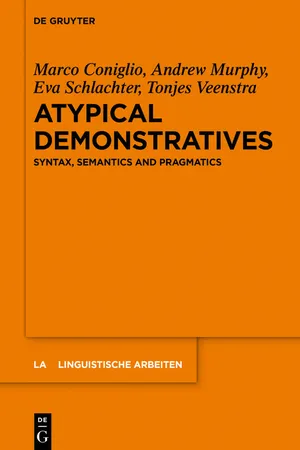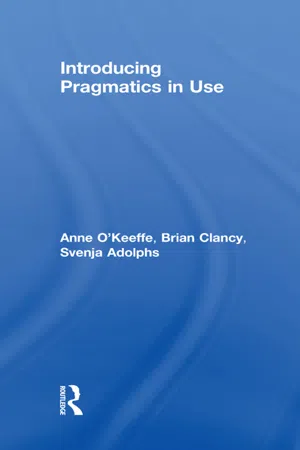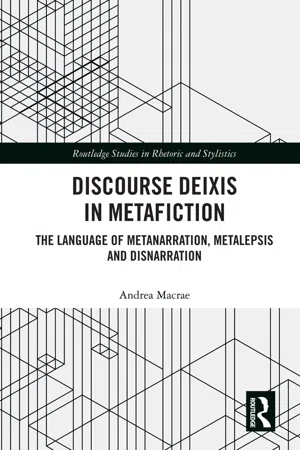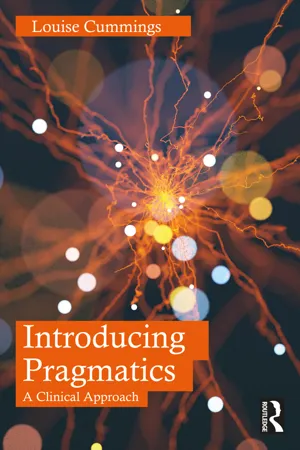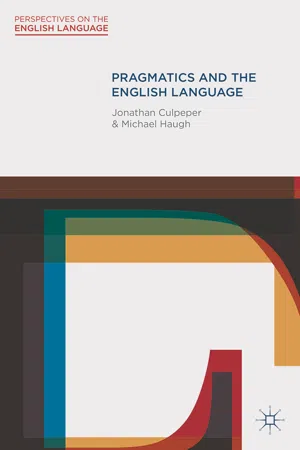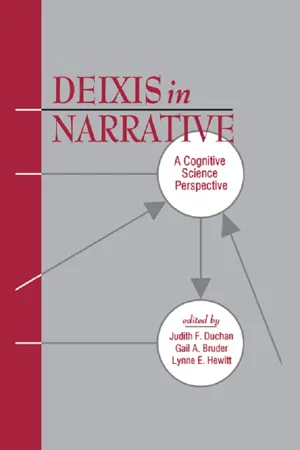Languages & Linguistics
Deictic expressions
Deictic expressions are words or phrases that rely on the context of the speaker and the listener to convey meaning. They include words like "this," "that," "here," and "there," which require the surrounding situation to be understood. Deictic expressions are essential for communication, as they help to establish spatial, temporal, and interpersonal relationships within a conversation.
Written by Perlego with AI-assistance
10 Key excerpts on "Deictic expressions"
Learn about this page
Index pages curate the most relevant extracts from our library of academic textbooks. They’ve been created using an in-house natural language model (NLM), each adding context and meaning to key research topics.
- eBook - ePub
Atypical Demonstratives
Syntax, Semantics and Pragmatics
- Marco Coniglio, Andrew Murphy, Eva Schlachter, Tonjes Veenstra, Marco Coniglio, Andrew Murphy, Eva Schlachter, Tonjes Veenstra(Authors)
- 2018(Publication Date)
- De Gruyter(Publisher)
here . These exemplify the three main types of deictic features, i.e. person, time and space (Bühler 1934: 102). Lyons (1977: 637) defines deixis as follows:[...] the location and identification of persons, objects, events, processes and activities being talked about, or referred to, in relation to the spatiotemporal context created and sustained by the act of utterance and the participation in it, typically, of a single speaker and at least one addressee.In addition, “real” demonstratives, typically instantiated by that , need what Kaplan (1989: 490) calls an associated demonstration, which ultimately can be traced back to Bühler’s (1934) notion of ‘origo’. Following König & Umbach (this volume) and many others, we define demonstratives as a subclass of Deictic expressions which are typically accompanied by a pointing gesture and whose reference can only be determined with respect to a center of orientation, the ‘origo’, which is determined by the utterance situation.A number of comprehensive monographs (or chapters thereof) have been devoted to demonstratives in various linguistic fields (Brugmann 1904, Diessel 1999, Dixon 2003, Roehrs 2009, a.o.). There, we find different classification criteria based on typological observations, exhaustive discussions of the properties of demonstratives in specific languages, etc. In this volume, we do not intend to offer either a novel typological classification or definition of the phenomena described. This book rather intends to capture the variability of demonstrative expressions based on a broad empirical basis. The individual chapters discuss (properties of) demonstratives that have not received the adequate attention (or have been completely neglected) in the literature. By providing fresh insights and discussing new facets, we intend to contribute to the better understanding of this group of words, starting from specific empirical phenomena. Our objective is to advance our knowledge on the various properties of demonstratives, on their syntactic multi-functionality, and on their semantic feature specifications and pragmatic functions. In addition, an aspect that emerged as orthogonal to most of the papers regards the grammaticalization processes involving demonstratives, in particular how and from which lexical and morpho-syntactic categories they originate cross-linguistically, and which semantic/pragmatic mechanisms characterize their emergence (cf. Diessel 2006, Himmelmann 1997). - eBook - ePub
- Anne O'Keeffe, Brian Clancy, Svenja Adolphs(Authors)
- 2011(Publication Date)
- Routledge(Publisher)
empathetic deixis are also examined. Woven through the chapter is the way in which corpus linguistic techniques can inform our study of deixis. Corpus techniques, such as word frequency lists, allow the researcher to bring into relief the importance of deixis in our everyday speech and writing. It is generally accepted that deixis is extremely prevalent in everyday speech and writing but corpus linguistics allows us to show just how frequent it is in relation to other grammatical features. Corpus linguistics also enables the researcher to conduct comparisons of how deixis is used across different genres (for example, casual conversation, academic discourse, and so on) as well as across different modes (spoken and written language).3.2 DEICTIC VERSUS NON-DEICTIC EXPRESSION
Personal pronouns, demonstratives (both pronouns and determiners) and adverbs of space and time can be used both deictically and non-deictically, as will be seen in the examples here. As we have already mentioned, to classify something as deictic means that the expression derives part of its meaning from the context. Deictics allow the interlocutors to ‘point’ to something in the context thereby enabling them to orientate themselves in a variety of ways, be it personally, spatially or temporally.Personal pronouns
The examples given in 3.1 demonstrate the use of a personal pronoun, in this case you, in both deictic and non-deictic senses:(3.1)Deictic usage Non-deictic usage A: I owe you a fiver. A: There’s a school that’s out there that you book in for a week and you can learn how to hang-glide. In the deictic usage of you, the speaker identifies a particular person, the addressee. In this example, the addressee is the referent . This deictic use of you in 3.1 is also likely to be accompanied by some gesture such as eye contact (in this example, a fiver refers to Irish and British English slang for a £5 or €5 note). In the non-deictic use, you is used to refer to people in general, and therefore does not rely on the context for meaning. In this example it is implied that anyone can learn how to hang-glide in this school, a usage similar to one in English, on in French or man in German. This usage is sometimes referred to as generic you (see Tao, 1998; Biber et al. - eBook - ePub
- Gunter Senft(Author)
- 2014(Publication Date)
- Routledge(Publisher)
2Pragmatics and psychology Deictic reference and gesture2.1 INTRODUCTION
How do speakers of different languages refer to objects, persons, animals, places, periods of time and even texts or text passages? When speakers make these so-called ‘deictic’ references, they communicate in certain – linguistic and non-linguistic – contexts, and these contexts influence the shape of our utterances. Natural languages are context-bound – and it is deixis that ‘concerns the ways in which languages encode or grammaticalize features of the context of utterance or speech event , and thus also concerns ways in which the interpretation of utterances depends on the analysis of that context of utterance’ (Levinson 1983: 54; see also Senft 2004a: 1). This contextdependence of linguistic reference is known as ‘indexicality’ and it is taken by philosophers such as Hilary Putnam (1975: 187; see also 193) as a ‘constitutive feature of human language’ and a general characteristic of language and interaction. Indexicality can broadly be defined as ‘the study of expressions relying on the context of use to select items of discourse’ (Corazza 2010: 1).In the first part of this chapter, the phenomenon of deixis is presented and discussed. The historically most influential contribution on the topic of deixis was presented by the German psychologist Karl Bühler (1879–1963) in his by now classic work Sprachtheorie: Die Darstellungsfunktion der Sprache (Theory of Language: The representational function of language - eBook - ePub
Discourse Deixis in Metafiction
The Language of Metanarration, Metalepsis and Disnarration
- Andrea Macrae(Author)
- 2019(Publication Date)
- Routledge(Publisher)
Use of a proper name also has a significant pragmatic and/or social indexical function in that the speaker has chosen to use the name instead of a pronoun, nickname, role title, etc. This may potentially be as a result of and/or to signal a particular social relationship (e.g. degree of familiarity) or an interaction between relationship and context (e.g. close friends may address each other using role titles and surnames in professional public contexts but may address each other using only first names outside of that environment) (Brown and Yule, 1983, pp. 44–45). Lyons tries to distinguish social relations and deictic relations (1977, pp. 574–575), though this is difficult in practice. (For more on the social pragmatic functions of proper names, and the broader, thornier issue of what has been called ‘social deixis’, see Macrae in Sorlin, forthcoming). Put briefly, though, the kinds of words and phrases which have been discussed under the heading of social and/or empathetic deixis are, firstly, not grounded in or referential via a deictic centre in the same way as person, spatial, temporal, and discourse deixis are, and secondly, as indicated in relation to proper names, they are bound up with pragmatics in ways which are often difficult to disentangle.To return to person deixis, on this basis one could perhaps argue that there is a scale of deictic quality within this category. Personal and demonstrative pronouns are wholly and inherently deictic in function, while the definite article and definite referring expressions are more occasionally and/or partially deictic in function, followed by proper names which are yet more rarely and/or minimally deictic in function.Spatial deixis includes spatial adverbs such as ‘here’ and ‘there’, ‘nearby’ and ‘beyond’; the demonstrative pronouns ‘this’, ‘that’, ‘these’, and ‘those’; and verbs of motion such as ‘come’, ‘go’, and ‘bring’ (Stockwell, 2002, pp. 45–46). Locative expressions such as ‘in the valley’ are included by some, which can be justified on the grounds of involving a definite referring expression (though some theorists consider such expressions to be non-deictic: cf. Fillmore, 1982).As explained by Herman (2001, 2002), spatial Deictic expressions can interact with figure and ground relations, whereby the deictic centre serves as the ground in relation to which the system of orienting co-ordinates moves (Fillmore, 1982; Langacker, 2008; Talmy, 2000). Spatial Deictic expressions can also interact with concepts of regions, landmarks, and paths (Landau and Jackendoff, 1993; Talmy, 2000), and with topological structures (the inherent geometric properties of object) (Frawley, 1992, pp. 250–293). For example, the statement ‘Steve is stood in front of the house’ may mean that Steve is stood between the speaker and the house, and is therefore in front of the house from the speaker’s perspective. In this case, the ‘ground’ is the speaker’s deictic centre, and the expression is deictic. Alternatively, Steve may be stood outside of the front of the house (usually conceived as the particular side of a house which includes its main—or indeed ‘front’—door). In this case the statement is drawing upon the perceived geometric properties of the object, and the ‘ground’ is that object, the house, rather than the speaker’s deictic centre. This sentence is not deictic, in that it is not related to the speaker’s perspective from her deictic centre: it could be equally ‘true’ and mean the same thing if the speaker was saying this from several different positions, for example while standing at the opposite side of the house to Steve, or while standing next to Steve at the ‘front’ of the house. The deictic quality of some spatial statements such as this may therefore occasionally be ambiguous, and those other factors (topological structures, etc.) may need to be considered in order to discern their deictic quality in each instance of use. - eBook - ePub
Introducing Pragmatics
A Clinical Approach
- Louise Cummings(Author)
- 2023(Publication Date)
- Routledge(Publisher)
4 DeixisDOI: 10.4324/9781003177562-5Learning objectives: By the end of this chapter, you will:- Understand how certain linguistic expressions can be used to ‘point to’ or ‘pick out’ entities in the context of an utterance. The lexical items that encode context in this way are indexical and their function is one of deixis.
- Appreciate that a wide range of words are indexical in this way, including demonstratives (e.g. that), adverbs (e.g. there), adjectives (e.g. last week), and pronouns (e.g. you).
- Reliably identify five categories of deixis: person deixis, social deixis, time deixis, place deixis, and discourse deixis.
- Understand that some expressions can function as more than one form of deixis such as the demonstrative in I walk home this way (place deixis) and I fly to Rome this week (time deixis).
- Be aware that while Deictic expressions look to context for reference, anaphoric expressions look to an antecedent within the utterance for reference.
- Appreciate that it can be difficult to establish in specific cases if an expression has a deictic function or an anaphoric function.
4.1 Introduction
You are walking through a market in town, and you overhear a stall owner saying to a customer What did you think of that? You continue walking through the market, and you pass two friends who are taking leave of each other. One says to the other I will meet you there tomorrow. As you wait at the bus stop, an elderly woman asks you What time is the next bus to the city centre? These utterances are representative of the hundreds that we use and hear every day that contain ‘pointing’ words. These are expressions like I, you, there, tomorrow, and that where we must look to the extralinguistic context of the utterance to establish the referents of these terms – semantic elements alone will not suffice to ‘pick out’ the referents. Because you are physically present when these utterances are spoken, you know the referents of the expressions you, I, tomorrow, and next bus. Your presence at each of these speech events allows you to determine that the pronoun you refers to the customer, and I refers to one of the two friends who are saying goodbye to each other. Meanwhile, tomorrow refers to an upcoming 24-hour period, and next bus refers to the bus for the city centre that will arrive after a particular point in time. But even from your unique vantage point, you are still not able to determine what the stall owner is referring to when he uses the demonstrative pronoun that, or the location that the friend refers to by means of the adverb there - eBook - ePub
- Jonathan Culpeper, Michael Haugh(Authors)
- 2014(Publication Date)
- Bloomsbury Academic(Publisher)
Thus, it has kono (near the speaker), sono (near the hearer) and ano (away from the speaker and hearer) (Kuno 1973: 27, cited in Diessel 2008). If one remembers the notion of deictic projection, as introduced above, one can see how this might work: for example, with sono the speaker projects the deictic centre onto the hearer. Such deictic systems have been described as person-based systems as opposed to distance-based systems (Anderson and Keenan 1985). Finally, we briefly note here that some Austronesian languages do not take any speech participants as deictic centres but orientate towards absolute geographical location points, such as seaward versus landward, or even simply co-ordinates like north, south, east and west. The final category in Table 2.2, temporal deixis, concerns expressions which can convey relations over time. As far as English is concerned, they typically express a relationship between a deictic centre and the time of the speaker’s utterance. Now refers to a span of time encompassing the speaker’s utterance; the use of the present tense as opposed to the past can mark the speaker’s current time of speaking (and auxiliary verbs such as will, shall, going to, etc. can mark some point in the future); tomorrow, next week, yesterday, ago, etc. indicate a span of time in relation to the speaker’s current utterance. Deictic expressions, as we have seen, are usually taken as referring to entities in the extralinguistic world. Some scholars have also distinguished discourse or textual deixis, which involves making a connection with a segment of discourse. Consider these (reconstructed) words said by a tutor at the end of a lecture in the UK: [2.15] That ’s the end. But don’t rush off just yet. As I said at the beginning, I have some announcements. Here they are. [Then displays and reads announcements on a Powerpoint slide] That points back to the preceding discourse (i.e. the lecture); here points to upcoming discourse - eBook - ePub
- Marta Fernández-Villanueva, Konstanze Jungbluth, Marta Fernández-Villanueva, Konstanze Jungbluth(Authors)
- 2016(Publication Date)
- De Gruyter(Publisher)
Soziolinguistik und Sprachgeschichte: Querverbindungen. Brigitte Schlieben-Lange zum 50. Geburtstag von ihren Schülerinnen und Schülern überreicht , 209–228. Tübingen: Narr.Passage contains an image Federica Da Milano, Università degli Studi di Milano-Bicocca
Deictic Strategies as Expression of Identity
Abstract: This contribution investigates the expression of personal deixis, often intertwined with two other aspects of deixis, namely spatial and temporal deixis, in two case-studies. Deictics are those linguistic forms whose interpretation essentially requires reference to some elements of the situation in which they are produced. As far as person reference is concerned, the act of referring to another individual leads us straight to the core of multimodal interaction: it is the first indicator of an individual cultural identity.The case-studies are represented by the utterances of Catalans living in Spain and by the narratives (life stories) of immigrants of different origins in Italy.Keywords: deixis, identity, person reference, personal pronouns, demonstratives“I is perhaps the most important and the least understoodof our everyday (every minute) expressions .This is a bizarre situation, a constant source of deep philosophical confusion ,and it calls urgently for treatment .”(M. de Gaynesford, I: the meaning of the first person term )1Introduction
Deictics are those linguistic forms whose interpretation essentially requires reference to some elements of the situation in which they are produced. As suggested by Lyons, “by deixis is meant the location and identification of persons, objects, events, processes and activities being talked about [. . .] in relation to the spatiotemporal context created [. . .] by the act of utterance and the participation in it, typically, of a single speaker and at least one addressee” (Lyons 1977: 637). As far as person reference is concerned, the act of referring to another individual leads us straight to the core of multimodal interaction: it is the first indicator of an individual cultural identity. Person reference is a subject that stands at a central intersection between various behavioural sciences, such as linguistics, sociology, psychology and philosophy. However, the empirical study of person reference in natural conversation has been curiously neglected, particularly from a cross-cultural perspective that might throw much needed light on the relation between culture, social structure and language use. - eBook - ePub
- Sebastian Loebner(Author)
- 2013(Publication Date)
- Routledge(Publisher)
deixis.The use of Deictic expressions not only anchors an utterance in the world, it also imposes the perspective of the speaker on the utterance. The speaker forms the so-called deictic centre; the ‘I’ is the one who decides who is being addressed; where the speaker is is ‘here’; when they speak is ‘now’. In the first part of this chapter, we will consider the three most important deictic relations: relation to the persons involved in the utterance (4.1 ), to the spatial situation (4.2 ) and to the time of utterance (4.3 ).4.1 PERSON DEIXISPerson deixis is deixis based on the linguistic category of person. The category of person relates to the roles that the participants take in an individual utterance: in the singular, the ‘1st person’ is the speaker, or producer, of the utterance, S for short; the ‘2nd person’ is the addressee,2 or A; the term ‘3rd person’ subsumes everybody who is neither first nor 2nd person.3 These roles are called discourse roles. In most languages the discourse roles play a role in grammar; these are languages that have the category of ‘grammatical person’. English is one of these languages: grammatical person plays a role in the choice of personal pronouns and the forms of fnite verbs (she says;I am;you are; etc.).The most salient linguistic means of person deixis are systems of personal pronouns. They may differ in the grammatical categories of person, gender, number and formality. Table 4.1 displays the personal pronouns in German. They form a paradigm, i.e. a closed system in which each slot is filled with a particular form. It often happens that there is the same form for more than one slot (this is known as syncretism) as is the case for the form sie/Sie in the German paradigm: sie is both 3rd person feminine singular (‘she’) and 3rd person plural (‘they’); Sie (with capital S ) is the 2nd person pronoun of formal address (recall the discussion in 2.3.1 - eBook - ePub
Deixis in Narrative
A Cognitive Science Perspective
- Judith F. Duchan, Gail A. Bruder, Lynne E. Hewitt, Judith F. Duchan, Gail A. Bruder, Lynne E. Hewitt(Authors)
- 2012(Publication Date)
- Psychology Press(Publisher)
The final source used here as evidence for the fact that interjections are complex predicational deictics that contain basic deictic elements in their semantic decomposition, is the use of deictic gestures as part of, or as an accompaniment to, interjections. In American Sign Language (ASL), for instance, where the majority of signs are restricted to a certain orientation within a fairly fixed signing space, many of the interjections are signed with a deictic movement in the direction of the particular entity (or entities) to which the interjection refers. So, for example, the sign that can be glossed as SMART ASS!; TOUCHÉ!; SICK- OF(-index) may be signed towards the addressee or towards someone outside of the conversation, depending to whom the speaker is referring. Similarly the sign that may be glossed as POOR BABY!; POOR THING (; PITY) may also be signed towards the addressee or towards someone else, and when it is used in a sarcastic or ironic sense it may also be signed directly towards the speaker. Thus, a deictic gesture is built into these signs just as they are built into the basic ASL pronominal and demonstrative forms.Except for the important fact that ASL interjections are clearly part of the general spatial-gestural linguistic mode of ASL as a language, the deictic orientation of these ASL forms is very similar to certain interjectional gestures used by English speakers. For example, when Americans “give someone the finger,” they not only raise their middle finger upwards, they also direct it towards the individual who is the target of their contempt. A reasonable gloss for this gesture would be the interjection(al phrase) “Fuck you!” that commonly accompanies it. It has already been noted, with respect to the Mpamtwe Arremte interjections, that deictic gestures may obligatorily accompany verbal interjections.In sum, then, the facts that conventional deictic elements are commonly incorporated as part of interjections, deictic elements may give rise to interjections, and deictic gestures may be built into (or may accompany) interjections, are taken as strong evidence in support of the conjecture that all interjections contain basic deictic elements in their semantic decomposition. At the very least, these facts argue that interjections must be included in any serious investigation of deixis.Once the claim that interjections are deictic elements is accepted, it is then possible to put forward some observations that are true of deictic elements generally. Previously we observed that languages may have conventionalised non- linguistic gestures that correspond to verbal interjections. The other areas of the lexicon that, cross-linguistically, commonly have gestural equivalents are the deictics par excellence, pronouns and demonstratives. Pronouns and demonstratives have their equivalents in conventionalised pointing gestures. For example, Arremte speakers employ a small set of conventional signs during everyday interactions: singular pronouns are commonly signalled by pointing the index finger towards the relevant person. For first-person singular, the gesture involves pointing toward one’s own upper chest or neck with the palm at a 45° angle from the body, whereas for the second-personal singular, the palm is facing upwards and the index finger points to the middle of the addressee’s chest. For third-person singular, the palm is face down and pointed towards the direction of a person outside the signed conversation. The demonstratives “this” and “that” may be signalled by a pointing gesture of the lips (by women), or by pointing with the index finger (palm downwards). Although less structured than the Arremte system, English speakers also regularly use conventional pointing gestures to signal “I,” “you,” “this,” “that,” “here,” and “there.” - eBook - ePub
- Mark Tutton(Author)
- 2016(Publication Date)
- De Gruyter Mouton(Publisher)
4 Defining and separating static locative expressions in oral discourse Having outlined the methodology for the collection and transcription of our data, the current chapter proposes a definition of the term static locative expression and presents the reasons behind this definition. It then discusses how static locative expressions are separated within the continuous flow of a describer’s discourse. This discussion of the definition and separation of static locative expressions introduces some of the key ways in which speakers use speech and gesture to communicate locative information in oral discourse. 4.1 Defining static locative expressions In Chapter 2, several ways in which different researchers have understood the concept of locative relationships were presented. The task of the current chapter is to present the interpretation of static locative expressions which will be applied in this study, and to detail the reasons behind this choice. The definition which we propose is as follows: Static locative expressions: Static locative expressions communicate the fixed location of an object or group of objects (the Figure) in space. The choice of the verb communicate in this definition is deliberate. It suggests that the expression of locative information is not modality specific, and therefore that both speech and gesture may play a part in this expression. The definition is simple and unrestrictive, and aims to cover the complete variety of ways in which speakers communicate location. Although not explicitly stated in the definition, there are other semantic components, apart from the Figure, which are inherent to locative expressions. As discussed in Chapter 2, Talmy identifies these other components as the Ground, Path and Motion. Given that we do not agree that static locative expressions can be categorised as Motion events, we will instead refer to this last semantic role as Location instead of Motion
